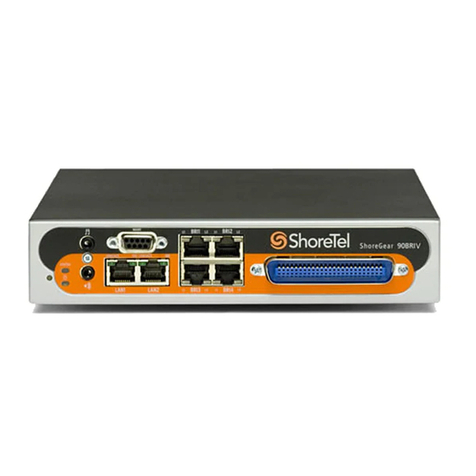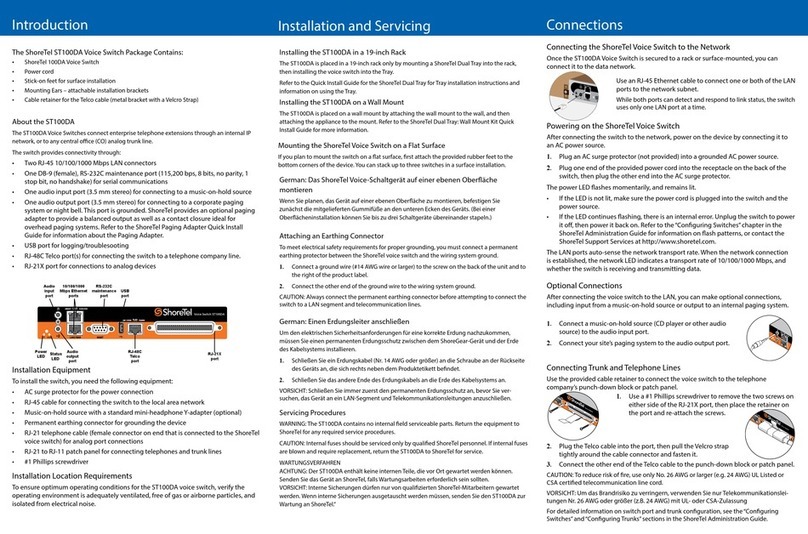Conguration, Status, Specications Network and Telco Status
Quick Install Guide
ShoreGear T1 / E1 Voice Switches:
SG-220T1 SG-220E1
SG-T1k SG-E1k
Copyright © 1998-2012 by ShoreTel Inc., Sunnyvale, California, USA. All rights reserved. Printed in the United States of America. Contents of this publication may not be reproduced or transmitted in any form or by any means,
electronic or mechanical, for any purpose, without prior written authorization of ShoreTel, Inc. ShoreTel, Inc. reserves the right to make changes without notice to the specications and materials contained herein and shall not be
responsible for any damage (including consequential) caused by reliance on the materials presented, including, but not limited to typographical, arithmetic or listing errors. ShoreTel, ShoreTel (and logo), ControlPoint, Brilliantly Simple,
Brilliantly Simple Communication, ShoreCare, ShoreGear, ShorePhone, and ShoreWare are registered trademarks of ShoreTel, Inc. in the United States and/or other countries. The ShoreTel logo is a trademark of ShoreTel, Inc. in the
United States and/or other countries. All other copyrights and trademarks herein are the property of their respective owners.
PN 850-1098-03
960 Stewart Drive Sunnyvale, California 94085
Phone: +1.408.331.3300 OR +1.800.425.9385 Fax: +1.408.331.3333 www.shoretel.com
Power LED
The power LED indicates the operating status of the switch.
Light Description
Steady The switch is powered on, and the internal software is running.
Flashing Two ashes indicates a failed internal self-test (i.e. hardware failure). Refer to “Conguring
Switches” in the ShoreTel Administration Guide for details on other ash patterns.
Off The switch is not powered on, or the software is not running.
Status LED
The status LED provides voice switch activity information.
Color Activity Description
Off No ports are assigned
Green Steady No ports are handling active calls
Green Flashing-Fast At least one port is handling an active call.
Yellow Steady No ports are handling active calls and at least one port is out of service.
Yellow Flashing-Slow The switch is not connected (or has lost connection) to a ShoreTel server.
Yellow Flashing-Fast At least one port is handling an active call and at least one port is out of
service.
Network Conguration
Once the ShoreGear voice switch is installed and powered on, it must be congured for
network operations. A voice switch gets a network conguration by assignment from a
DHCP or BOOTP server, or directly from an administrator console (see procedure below).
For more information on setting up a switch for automatic conguration by a DHCP or
BOOTP server, see the ShoreTel Planning and Installation Guide.
Conguring the Voice Switch from a Console
1. Use a straight-through serial cable, DB9 male to DB9 female, to connect the switch to a
console PC.
2. On the PC or laptop, start a terminal emulation program and connect to the voice switch
using these serial communication settings: 19200 bps, 8 data bits, no parity, one stop bit, no
handshake.
3. At the login prompt, enter:
Login: anonymous
Password: ShoreTel
4. Choose Menu Options and follow the onscreen instructions for setting network parameters,
including IP address, subnet mask, and gateway.
Specications
Feature Specication
Dimensions 1.69 x 8.39 x 14.28 inches (43 x 213 x 378)
Weight 5.3 lb (2.4 kg)
Input voltage 100-240 VAC, 50-60 Hz
Power consumption 1A max.
Humidity 0-90% relative humidity (non-condensing)
Operating temperature 0-50˚ C
T1 LEDs (SG-220T1, SG-T1k)
T1 LEDs indicate line coding, network framing, and loopback status. The Line Coding
LED is on the port’s left side. The Framing LED is on the port’s right side.
LED Color/State Description
Line coding Green The AMI or B8ZS line coding signal is good.
Line coding Yellow This switch is receiving bipolar violations (BPV) at one-second intervals.
Line coding Red A loss of signal (LOS) has occurred.
Line coding Off The switch has no power.
Framing Green The T1 signal is in frame (synchronized)
Framing Yellow The CO has sent a yellow alarm.
Framing Yellow-Flashing The frame-bit error rate has exceeded its limits
Framing Red T1 signal is out-of-frame (OOF) and cannot be framed to the Extended
Superframe (ESF) or D4 format.
Framing Off The switch has no power.
LC/Framing Red-Flashing Loopback is enabled. (Loopback can be set from Shoreline Director or
at the CO).
Network LEDs
Each LAN connector provides two LEDs: Link/Act (Left) and 100 (Right). LAN LEDs
indicate the activity and communication speed of the connected network.
LED Color/State Description
Link/Act Off This switch cannot detect an Ethernet network.
Link/Act Green-Steady This switch is connected to an Ethernet network.
Link/Act Green-Flashing This switch detects network data trafc.
100 Off Network interface is operating at 10 Mbps.
100 Green Network interface is operating at 100 Mbps.
E1 LEDs (SG-220E1, SG-E1k)
E1 LEDs indicate line coding, network framing, and loopback status. The Line Coding
LED is on the port’s left side. The Framing LED is on the port’s right side
LED Color/State Description
Line coding Green The HDB3 line coding signal is good.
Line coding Yellow This switch is receiving bipolar violations (BPV) at one-second intervals.
Line coding Red A loss of signal (LOS) has occurred.
Line coding Off The switch has no power.
Framing Green The E1 signal is in frame (synchronized)
Framing Yellow The CO has sent a yellow alarm.
Framing Yellow-Flashing The frame-bit error rate has exceeded its limits
Framing Red E1 signal is out-of-frame (OOF).
Framing Off The switch has no power.
LC/Framing Red-Flashing Loopback is enabled. (Loopback can be enabled from ShoreTel Director.)
































